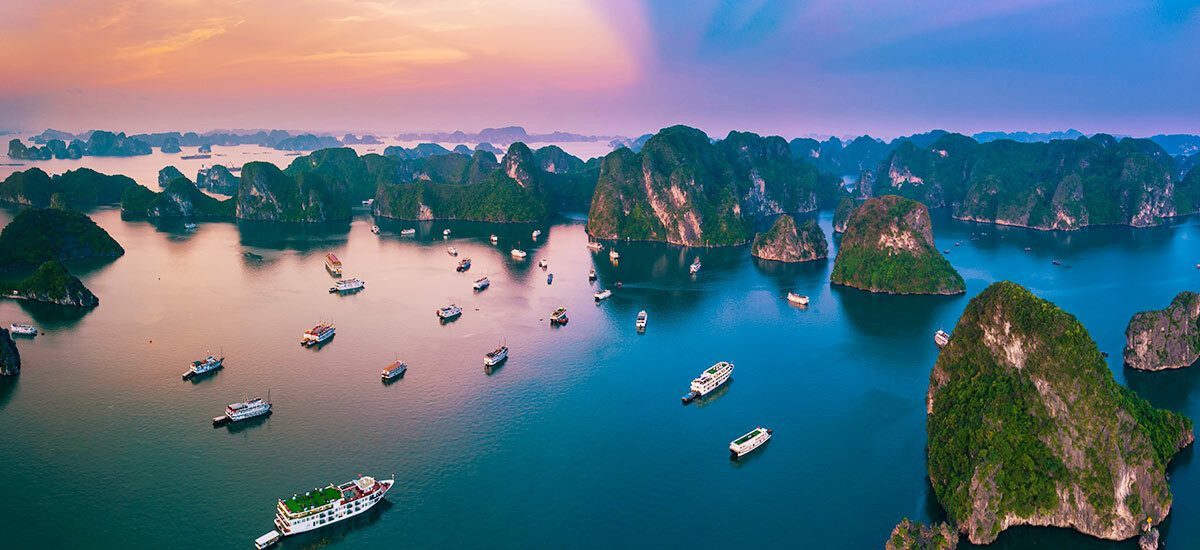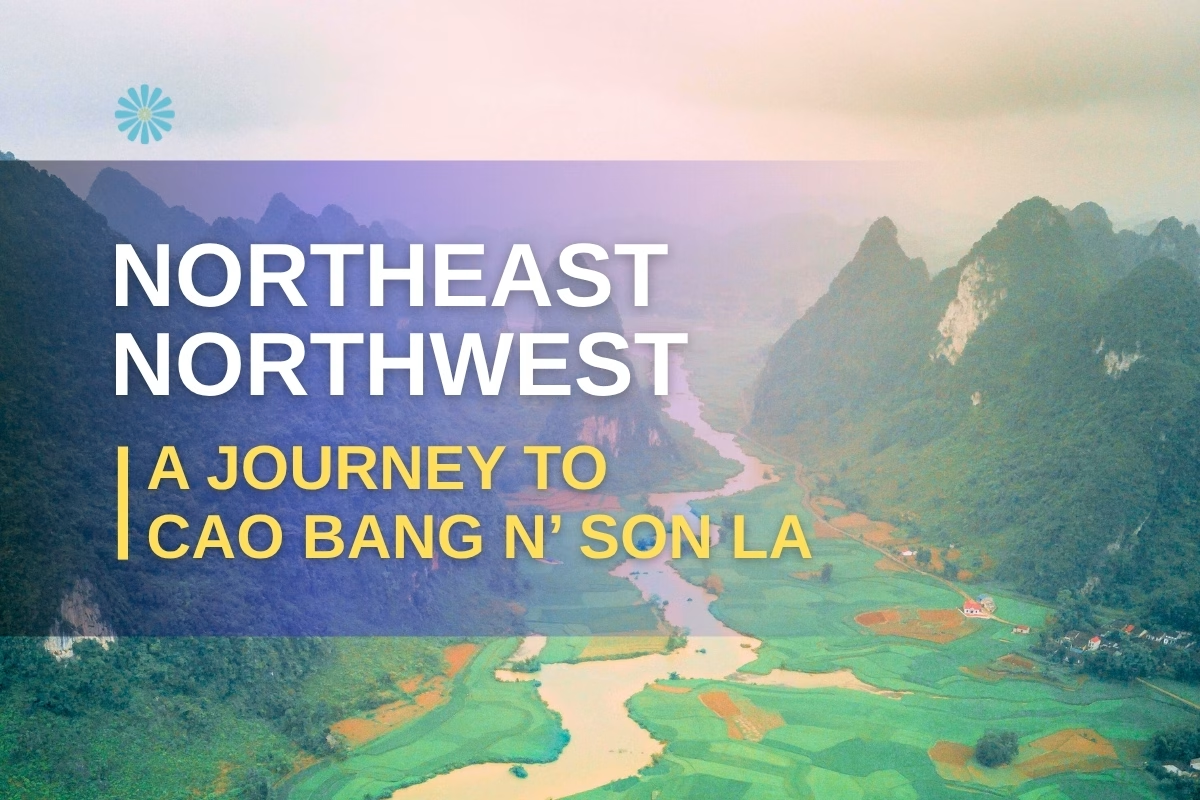Explore Northeast and Northwest Vietnam
A Journey to Cao Bang and Son La
Northeast and Northwest Vietnam is a land where stunning nature meets rich local cultures, offering a journey full of wonder. Ban Gioc Waterfall in Cao Bang, with its powerful cascades amidst lush mountains, is a natural masterpiece. Meanwhile, Moc Chau in Son La captivates with its green tea hills, pristine forests, mysterious caves, and breathtaking passes like Thung Khe and Pha Luong. This adventure, filled with trekking trails and authentic local experiences, invites you to immerse yourself in the wild beauty and vibrant traditions of Northeast and Northwest Vietnam tourism.
Ban Gioc Waterfall, Cao Bang: A Gem of Nature
The Majestic and Poetic Beauty of Ban Gioc Waterfall
Located in Dam Thuy Commune, Trung Khanh District, Cao Bang, about 370 km from Hanoi, Ban Gioc Waterfall is one of Vietnam’s most beautiful waterfalls and the largest in Southeast Asia. Nestled along the Quay Son River, marking the border between Vietnam and China, the waterfall is divided into two parts: the main waterfall, with its western half in Vietnam and eastern half in China (known as Detian Falls), and the secondary waterfall, entirely within Vietnam. The main waterfall, about 30 meters high, stretches hundreds of meters wide, with water cascading over multiple limestone tiers, creating a scene that’s both grand and serene.

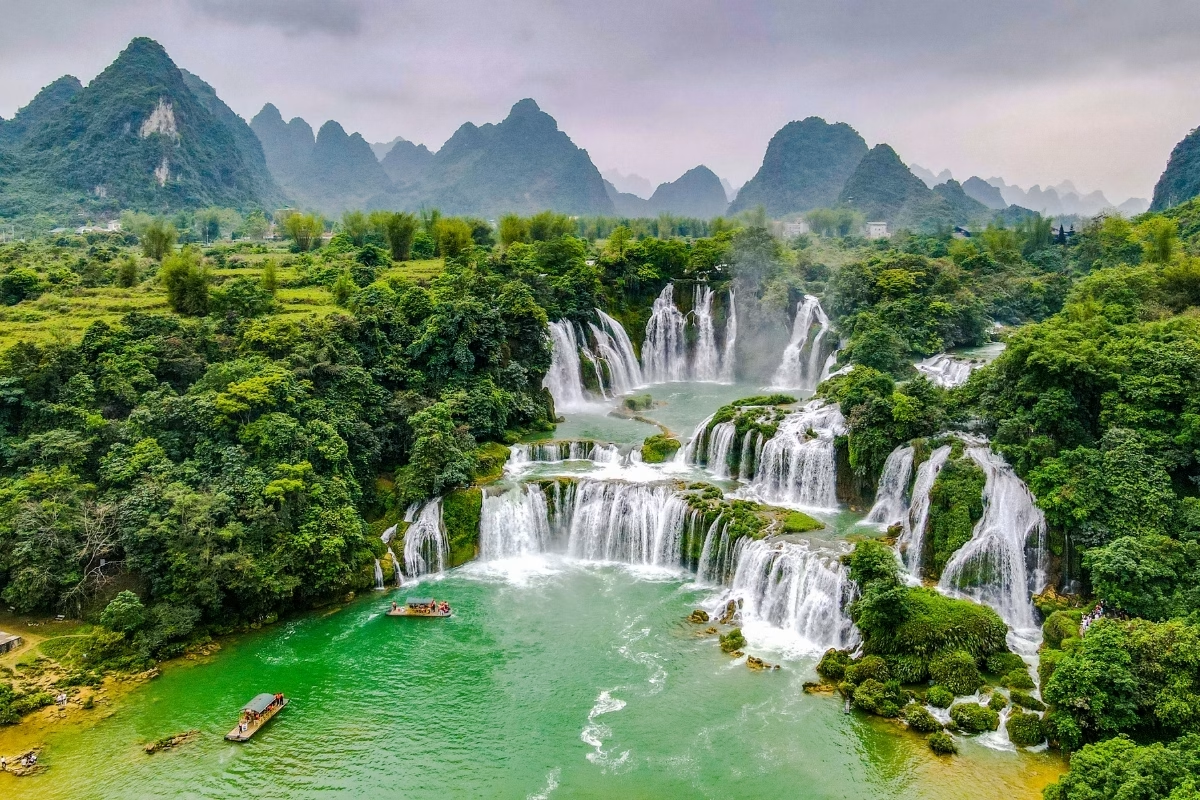
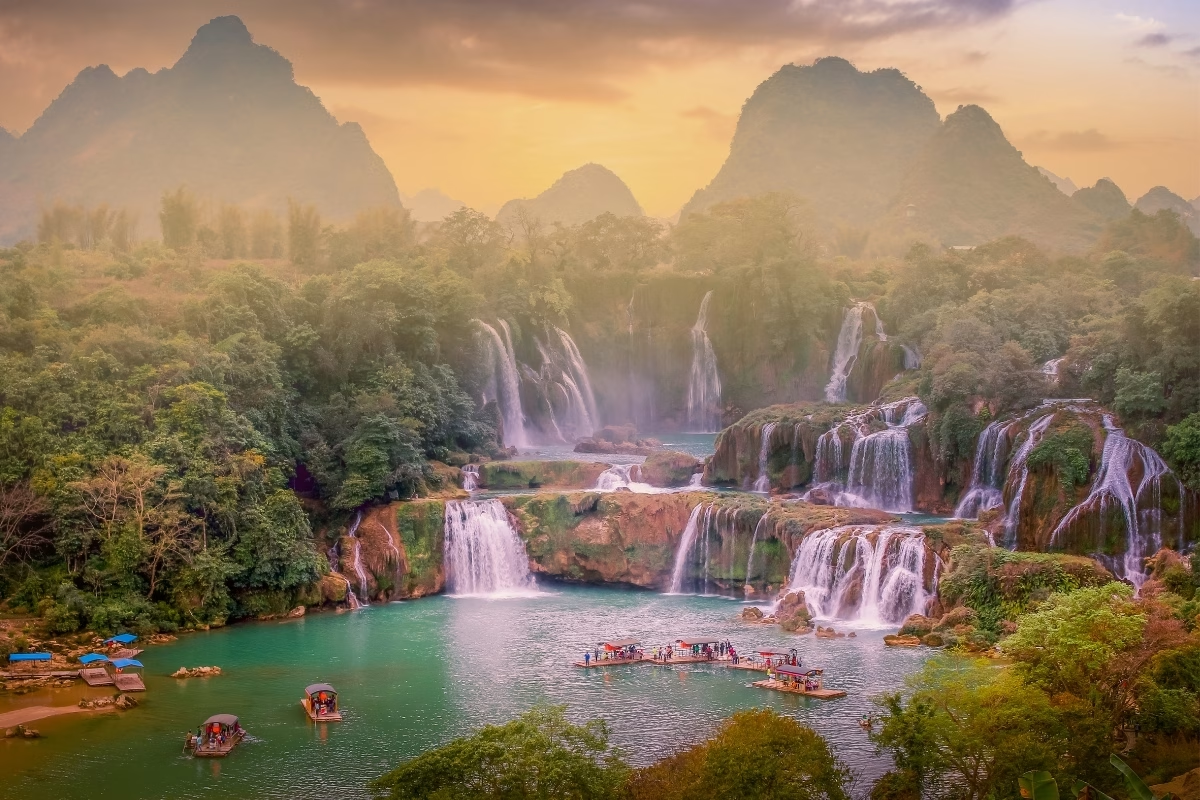
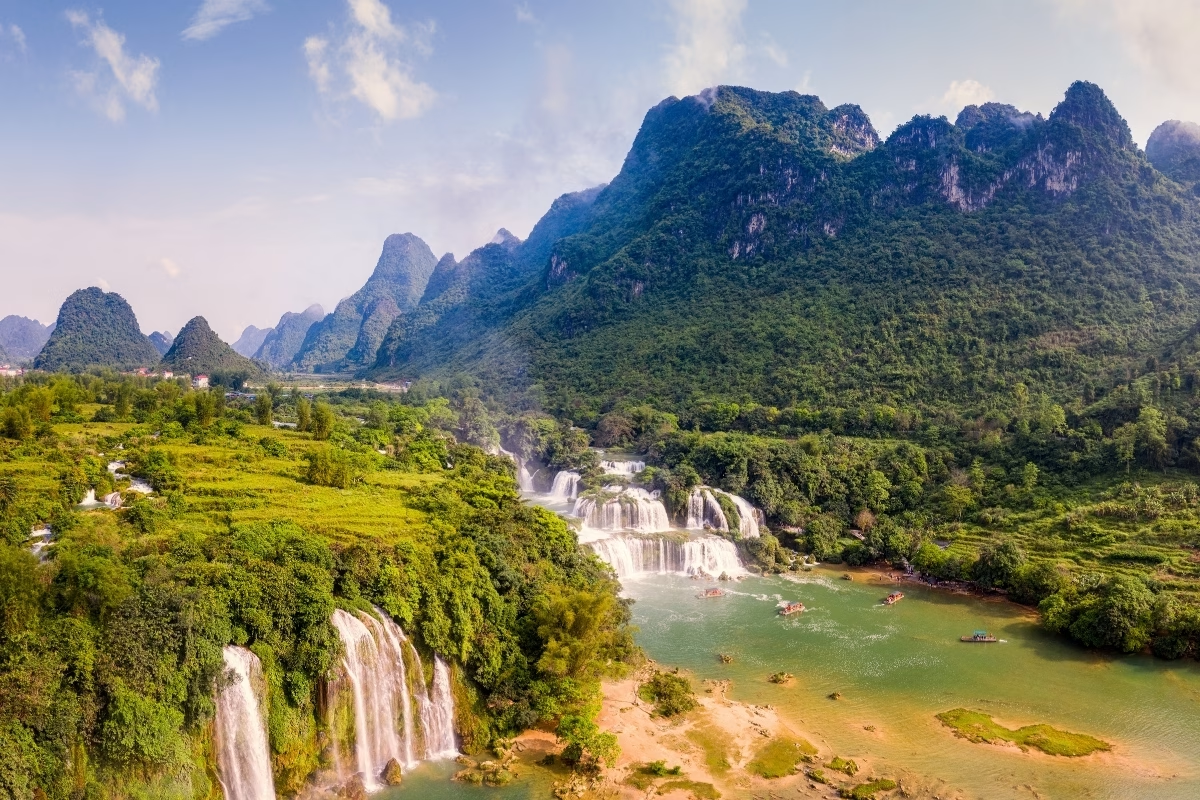
During the rainy season (June to September), Ban Gioc Waterfall roars with powerful red-tinted flows, sending up clouds of white mist that echo through the mountains. In the dry season (October to May), the waterfall calms, revealing clear waters and unique limestone formations at its base. In September and October, when the rice fields in Trung Khanh turn golden, the waterfall’s surroundings become even more vibrant, with lush paddies contrasting the silvery cascades. When sunlight filters through the mist, rainbows often appear, painting a magical picture.
Riding a bamboo or motorboat on the Quay Son River is a must-do experience, letting you glide beneath the waterfall and feel the cool spray and hear the roar of the water. From this angle, the waterfall’s grandeur is undeniable, with massive streams plunging from tens of meters high, creating nature’s own symphony. The area around the waterfall is framed by dense virgin forests and green meadows, home to diverse wildlife, enriching the region’s ecosystem.
Trekking and Exploring Nguom Ngao Cave
Just 3 km from Ban Gioc, Nguom Ngao Cave is a must-visit for nature lovers. In the Tay language, “Nguom Ngao” means “Tiger Cave,” hinting at its mystical allure. Discovered in 1921, this cave stretches over 2 km and is a geological wonder, filled with glittering stalactites shaped like lotus blossoms, terraced fields, or golden waterfalls. As you walk through, light seeping through rock crevices highlights the stalactites, while the sound of underground streams creates a soothing melody.
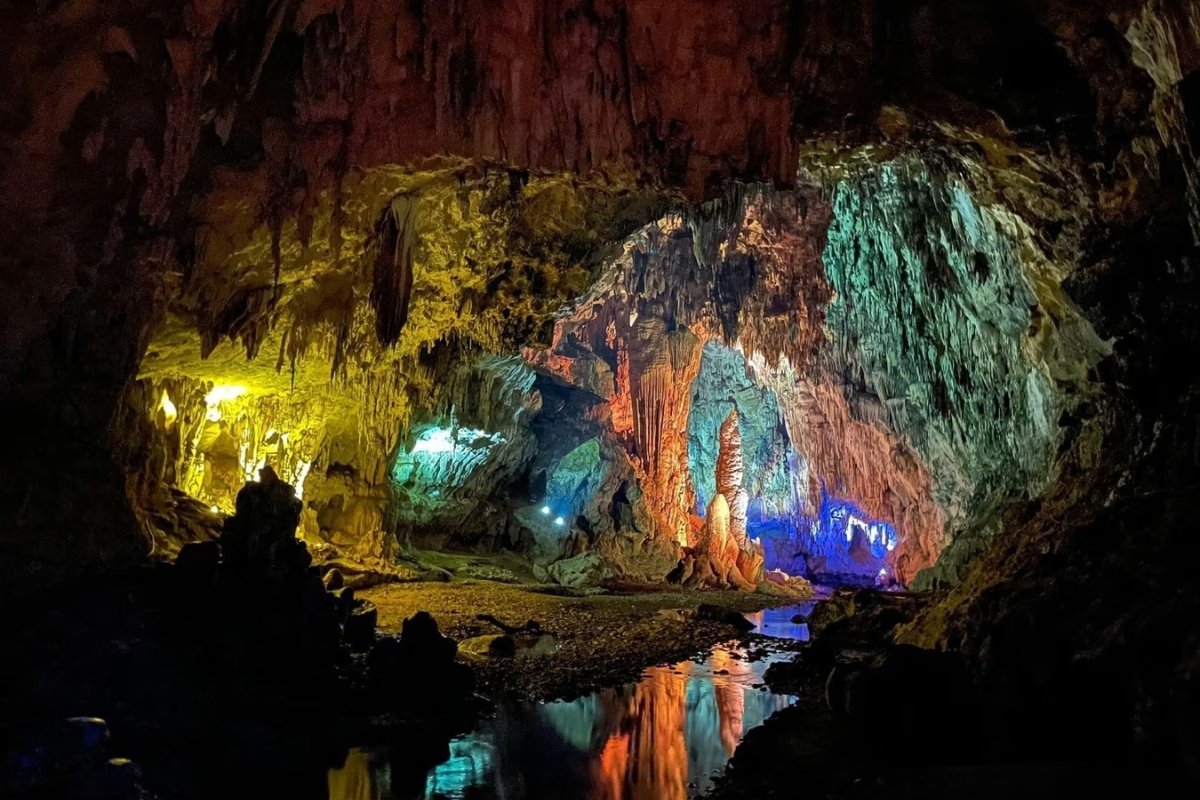
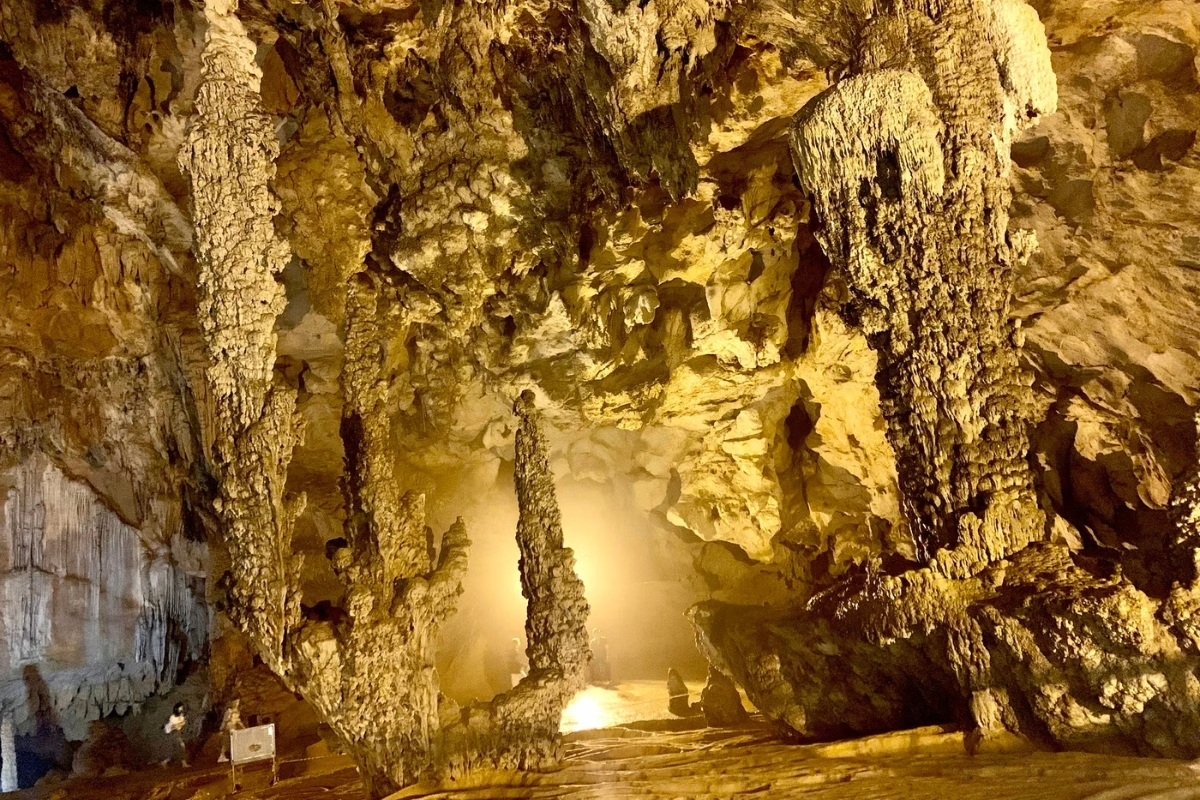
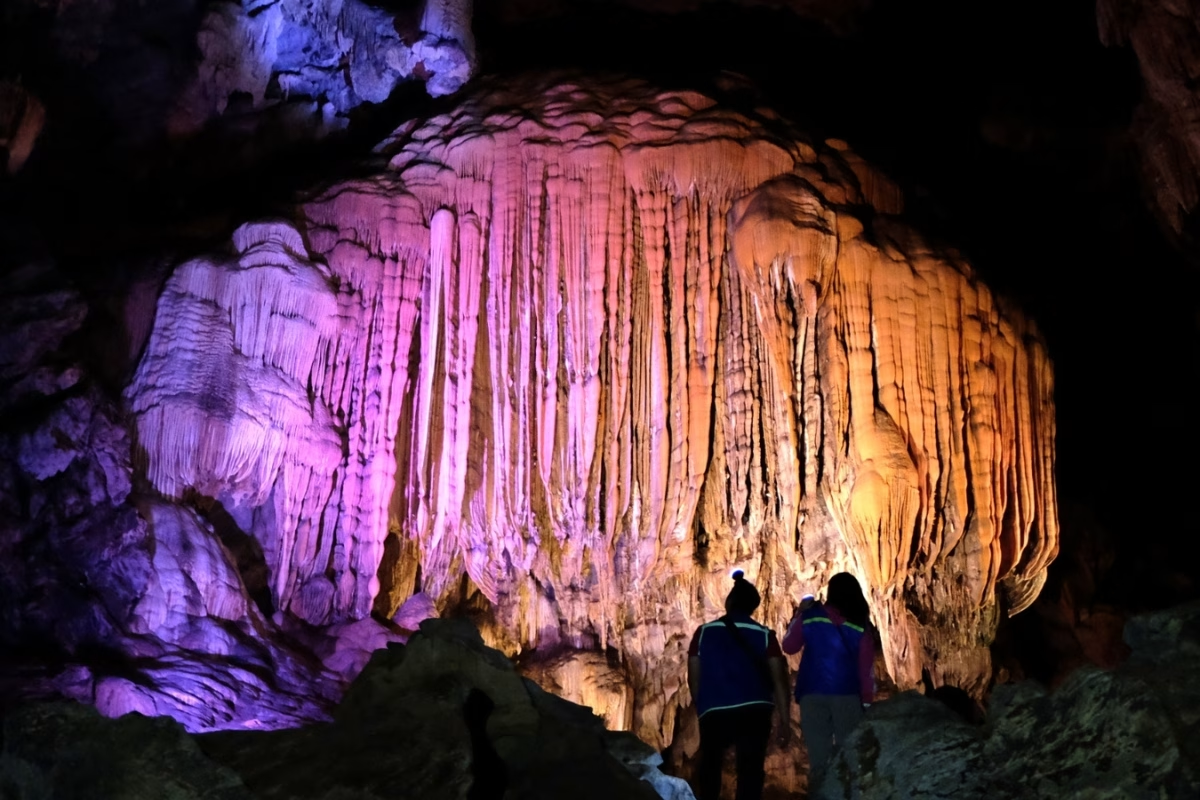
Trekking routes around Ban Gioc Waterfall and Nguom Ngao Cave wind through virgin forests, terraced fields, and Tay villages, offering lush green scenery and crisp air. These trails are manageable for beginners, with breathtaking views of the waterfall from higher vantage points, showcasing its cascading beauty against the vast wilderness. Trekking here is not just about exploring nature but also about discovering Cao Bang’s unique ecosystem.
History and Culture Around Ban Gioc Waterfall
Ban Gioc is more than a natural wonder—it holds deep historical significance. In the 1950s, this area witnessed battles during Vietnam’s resistance against French colonial rule. Nearby, the Phat Tich Truc Lam Ban Gioc Pagoda, just 500 meters from the waterfall, offers a serene space for reflection and panoramic views of the falls. Built in traditional Vietnamese Buddhist style, it’s a peaceful spot to soak in the scenery. About 60 km away, the Pac Bo Historical Site, with Lenin Stream and Coc Bo Cave, marks where President Ho Chi Minh lived and worked during the resistance, blending historical reverence with poetic natural beauty.
Moc Chau, Son La: A Tapestry of Natural Wonders
Moc Chau’s Tea Hills: Endless Green
Moc Chau, in Son La Province, is renowned for its sprawling tea hills, stretching like green carpets over rolling hills. In the early morning, when mist lingers, Moc Chau looks like a watercolor painting, with tea rows curving gently under the sunrise. Trekking through tea hills like the heart-shaped tea plantation or Tan Lap tea fields lets you touch tender tea leaves, breathe fresh air, and sip freshly picked green tea, its rich, fragrant taste a gift from nature.
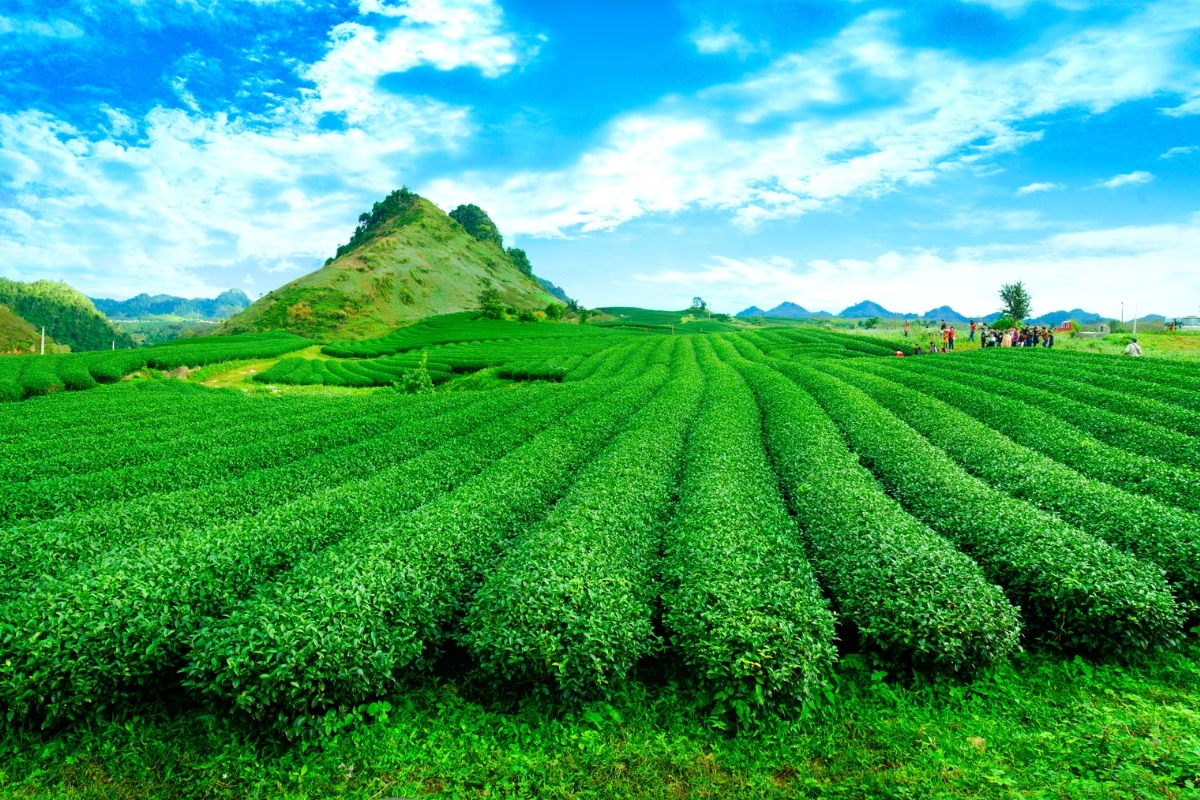
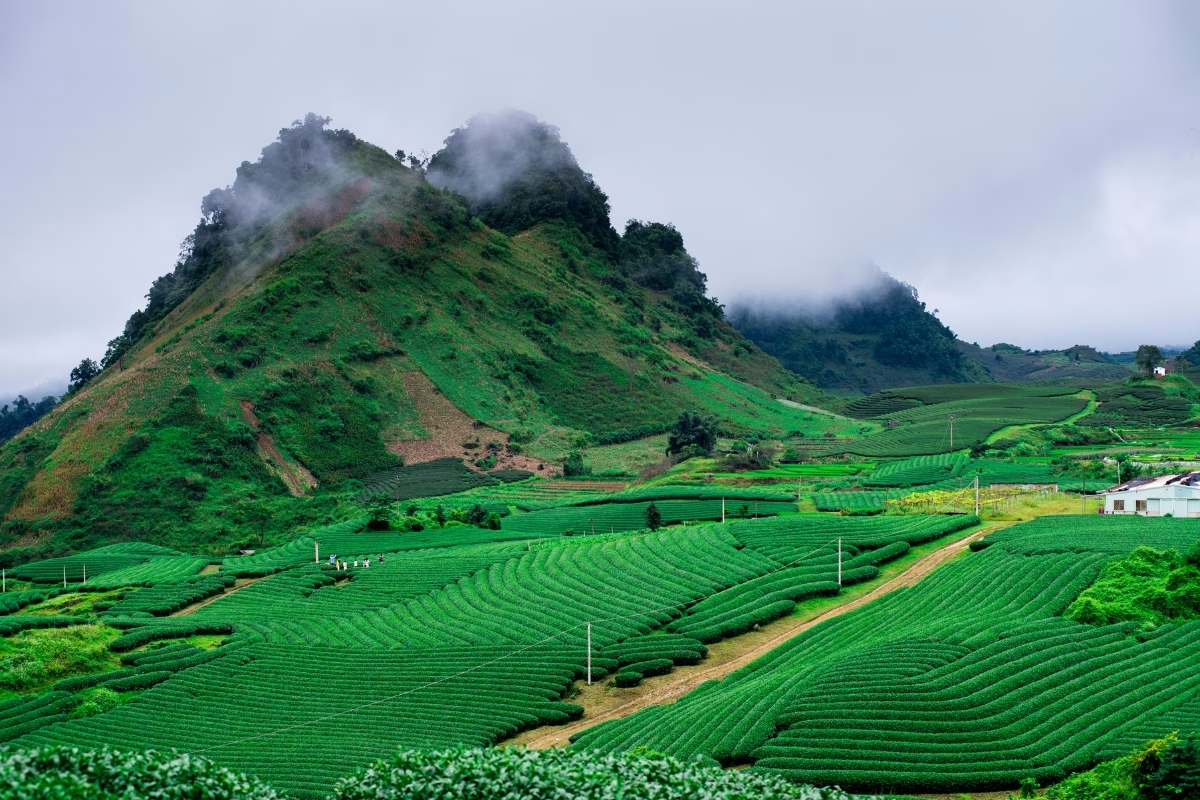

Moc Chau’s Diverse Natural Beauty
Beyond its tea hills, Moc Chau boasts a range of natural attractions, from virgin forests and caves to dramatic mountain passes. Ban Ang Pine Forest is a standout, with towering pines shading a serene lake. This tranquil spot is perfect for picnics or overnight camping, with the sound of wind through the pines and the lake’s shimmering surface creating a peaceful retreat.
Bat Cave, a karst cave in Moc Chau town, is another gem. Its glittering stalactites and cool interior offer an exciting exploration, surrounded by lush forest. Dai Yem Waterfall, with water plunging over 100 meters, is a refreshing stop, its cool mist a welcome break amidst stunning scenery.
Moc Chau is also home to two iconic passes: Thung Khe Pass and Pha Luong Pass. Thung Khe Pass, also known as White Rock Pass, lies between Mai Chau and Moc Chau, famous for its white limestone cliffs and misty atmosphere. Winding curves offer sweeping views of green valleys, making it a thrilling ride or trek. Pha Luong Pass, dubbed “Moc Chau’s rooftop,” sits near the Vietnam-Laos border, rising over 1,500 meters. Its rugged cliffs and vast mountain vistas make it a challenging yet rewarding destination for trekkers and adventurers, with crisp highland air and unparalleled scenery.
Ethnic Minority Cultures: The Heart of Northeast and Northwest Vietnam
Tay and Nung People in Cao Bang
Cao Bang is home to the Tay and Nung, known for their hospitality and rich traditions. Wooden stilt houses, vibrant highland markets, and soulful “then” songs define the region. Joining locals to make banh chung (sticky rice cakes) or weave brocade offers a glimpse into their lives. Markets like Trung Khanh Market, held on the 5th, 10th, 15th, 20th, 25th, and 30th of the lunar month, buzz with activity, showcasing unique handicrafts and local flavors like khau nhuc (braised pork).
Thai People in Moc Chau
Moc Chau is home to the Thai ethnic group, whose vibrant culture captivates visitors. Staying overnight in a homestay in villages like Ban Ang or Pa Phach, you’ll savor traditional dishes like sticky rice, smoked meat, or grilled fish (pa pinh top). Gatherings around a fire, sipping rice wine, and watching graceful Thai xoe dances create unforgettable memories. The Thai people’s warm hospitality shines through their welcoming smiles.
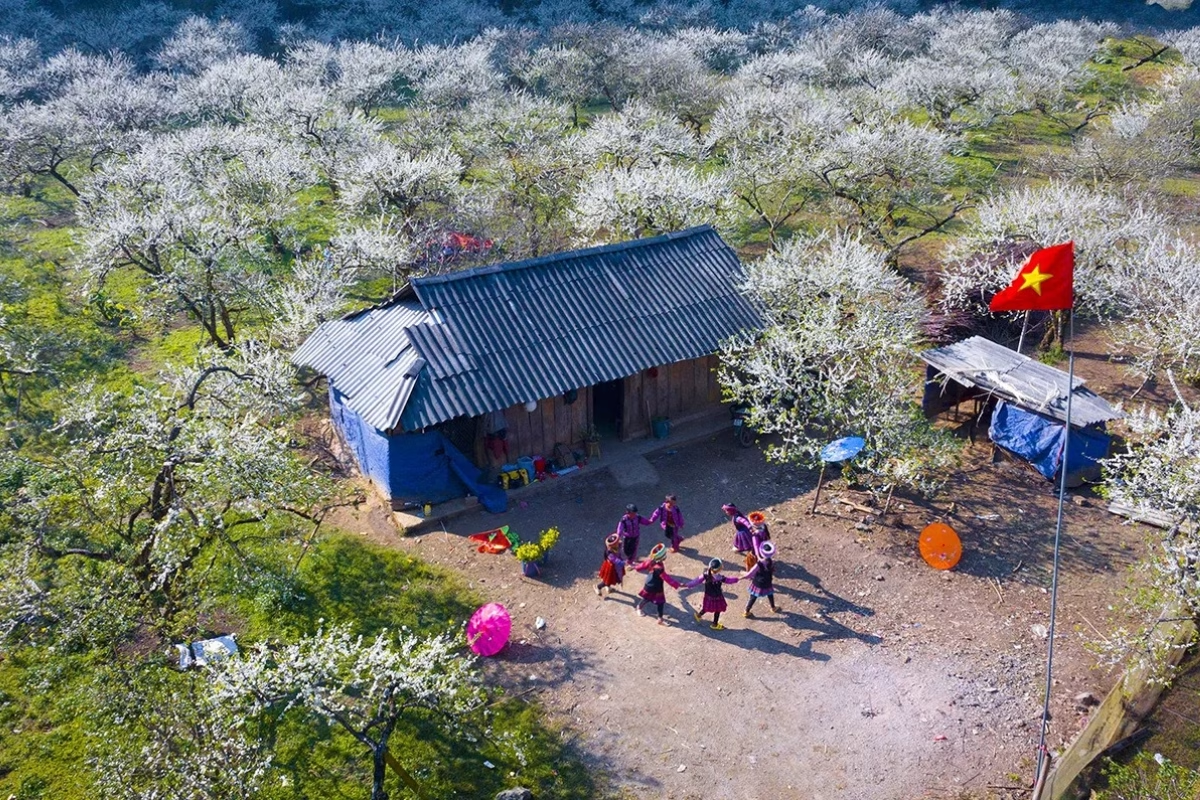
You can also try weaving traditional brocade or donning Thai clothing with intricate patterns. During festivals like the Ban Flower Festival in March, Moc Chau comes alive with dances, bamboo flute melodies, and colorful markets, offering a deep dive into local culture.
Trekking: Touching the Heart of Northeast and Northwest Vietnam
Inspiring Trekking Routes
Cao Bang and Moc Chau are trekking paradises. In Cao Bang, trails through Tay villages, terraced fields, and virgin forests bring you closer to nature, with some routes offering high vantage points for stunning views of Ban Gioc Waterfall. In Moc Chau, trekking through tea hills, Ban Ang pine forests, or up Pha Luong Pass is exhilarating, with cool highland air and sweeping vistas. The trek to Pha Luong’s peak is a thrilling challenge, rewarding you with dramatic mountain scenery.
Trekking Tips
For safe trekking, wear non-slip shoes, long-sleeved clothing to protect against sun and insects, and carry water to stay hydrated. Summer in Northeast and Northwest Vietnam can be warm, but evenings in Moc Chau are cool, so pack a light jacket. Bring sunscreen, a hat, and insect repellent, and don’t forget a camera or phone to capture the breathtaking landscapes.
Plan Your Trip
Exploring Cao Bang and Son La is a chance to experience the raw beauty of Northeast and Northwest Vietnam tourism. A 5- to 7-day trip allows you to discover Ban Gioc Waterfall, Nguom Ngao Cave, Moc Chau’s tea hills, Ban Ang pine forest, and the dramatic Thung Khe and Pha Luong passes. From Hanoi, travel by bus or motorbike to Cao Bang (8-10 hours) or Moc Chau (4-5 hours). Guesthouses and homestays in Trung Khanh (Cao Bang) and Moc Chau town (Son La) offer comfortable, affordable stays.
This journey through Northeast and Northwest Vietnam engages all your senses, blending majestic nature with vibrant local life. Plan your Vietnam tourism adventure to Cao Bang and Son La today!
Daisy Land Travel Viet Nam (DLT)
- 🏢 Head Office: No. 11, Alley 55, Linh Quang Alley, Van Chuong Ward, Dong Da District, Hanoi, Vietnam
- 📞 Phone/ Whatsapp/ Viber: (+84)931307887 / (+84)368020960
- 📧 Email: booking.daisylandtravelvietnam@gmail.com
Khám phá thêm từ Daisy Land Travel Viet Nam
Đăng ký để nhận các bài đăng mới nhất được gửi đến email của bạn.

